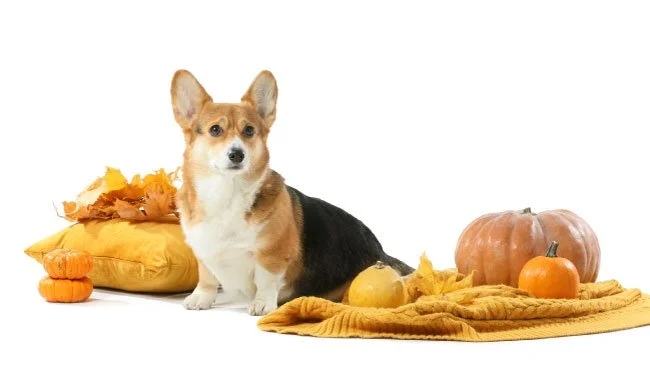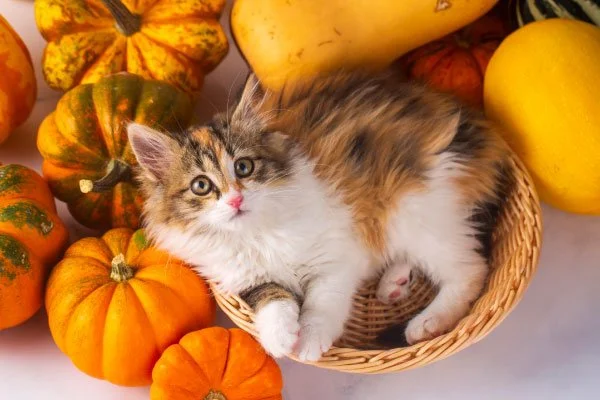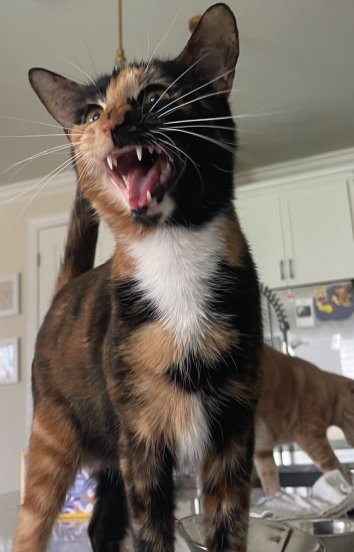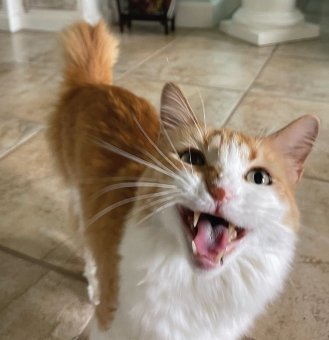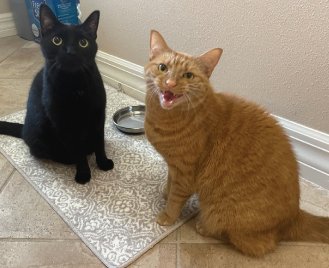Pumpkin: A Pet’s Fall Favorite
While you're sipping your latte or baking pies, don’t forget your furry friend can enjoy pumpkin too! Both cats and dogs can safely enjoy this festive favorite, and it’s more than just a tasty treat!
Whether your pet is dealing with a bit of constipation or the opposite problem, pumpkin can be a gentle, natural way to help. Thanks to its high fiber content, just a spoonful of plain canned pumpkin can help regulate digestion and keep your cat or dog’s tummy feeling good. It’s a simple, tasty fix for those occasional digestive hiccups and most pets love the flavor too!
Pumpkin is low in calories, but high in fiber, which means it helps your dog or cat feel full without the extra calories. It’s a great way to add a little bulk to their meals and keep them satisfied longer if you’re trying to get your pet to shed a few extra pounds.
Packed with vitamin A, zinc, and healthy fatty acids, pumpkin can help improve your pet’s skin and coat. Whether your dog’s dealing with dry skin or your cat needs a little extra shine, adding a bit of pumpkin to their meals can help them look and feel their best. It’s like a spa day, but in a bowl.
Pumpkin has a high water content, which can help keep your pet hydrated—especially if they’re not big water drinkers. Adding a spoonful to their food is an easy way to support hydration while also giving them a tasty, nutrient-rich treat.
Who knew something as humble as pumpkin could be such a powerhouse for your pet? Whether it’s helping with digestion, adding a little shine to their coat, or just being a tasty treat, pumpkin’s got a lot going for it.
Just remember—plain, unsweetened pumpkin only, and always check with your vet before making it a regular thing. A spoonful here and there could make a big difference (and earn you some serious tail wags or purrs).
Reference:
What Fruits and Vegetables Can Dogs Consume? Which Should They Avoid?
While some fruits and veggies can be a great addition to your dog’s diet, others can cause anything from an upset tummy to serious health issues. Knowing the difference isn’t just helpful, it’s essential to ensure your pup lives a long and healthy life!
️✔️ Safe Fruits for dogs (in moderation):
Blueberries: packed with antioxidants and fiber, all while low in calories.
Strawberries: high in vitamins A & C, helps with teeth whitening.
Watermelon is hydrating and vitamin-rich; remove all seeds and the rind.
Cantaloupe: full of beta carotene and water, offered in small seedless chunks.
Mango: loaded with vitamins A, B6, C, and E. Always remove the pit, as it contains cyanide.
❌ Unsafe Fruits for Dogs:
Grapes: extremely toxic, can cause kidney failure.
Avocado: contains persin, which could cause GI issues and heart problems.
Lemons: too acidic and may cause central nervous system depression, as well as GI issues.
Cherries: pits and stems contain cyanide, while the whole cherry is a choking hazard.
Figs: can cause extreme diarrhea and upset stomach.
✔️ Safe Vegetables for Dogs:
Kale, in moderation, supports immune health and contains calcium.
Green Beans: great for fiber and vitamins.
Cucumbers: hydrating and crunchy.
Sweet Potatoes: must be fully cooked, packed with fiber and vitamin A.
Pumpkin: excellent for digestion and an upset tummy.
❌ Unsafe Vegetables for Dogs:
Onions: can destroy red blood cells and lead to anemia.
Garlic: can cause toxicity over time.
Tomatoes: While ripe tomatoes themselves are safe, unripe tomatoes and their stems contain solanine.
Rhubarb: can cause kidney failure and drop calcium levels.
Wild Mushrooms: many may be toxic and therefore deadly.
References:
What fruits and vegetables can dogs eat? - Blue Cross
Fruits and Vegetables Dogs Can or Can’t Eat – American Kennel Club
Pup Eating Watermelon Photo: iStock Credit Anna Belova and Canva Premium
Pup with Carrot — Purina US photo
5 Things To Do When Your Dog Won’t Potty Outside In Bad Weather
Dealing with a dog that refuses to potty in the rain can be frustrating, but with the right strategies, it’s possible to make it easier for you and your pup. In this blog, we’ll share five helpful tips for getting your dog comfortable outside in the rain.
Look for a covered area to potty
Looking for a covered area, such as a large tree or large umbrella, for your dog to potty during bad weather can provide a sense of security and comfort. A sheltered spot can encourage your dog to go outside when they might otherwise hesitate, ensuring they get the bathroom break they need.
Wear rain gear
Wearing rain gear like a raincoat and booties can make potty time more comfortable for you and your dog during bad weather. The raincoat keeps your dog dry and warm, while the booties protect their paws from getting cold or wet, preventing discomfort or irritation. This can make them more willing to go outside and do their business, as it reduces the negative impact of the weather on their experience. Plus, it helps keep them clean and dry when they return inside.
Get your dog used to the rain
To slowly start taking your dog outside in the rain, expose them to light rain for short periods. Use positive reinforcement like treats and praise when they go outside, even if they just stand there. Gradually increase the time spent outside and the intensity of the rain as they become more comfortable.
Try pee pads
If your dog refuses to go outside in the rain, you can try using pee pads as a temporary solution. Set up a designated potty area with a pee pad in a quiet, easy-to-access spot inside. Encourage your dog to use the pad by guiding them over it and offering praise or treats when they go. Over time, they may learn to associate the pad with potty time, especially during bad weather.
Bring their favorite toy
Bringing your pup's favorite toy outside during potty time in the rain can help distract them from the discomfort of the wet weather and make the experience more enjoyable. The toy can serve as a positive reinforcement, offering something familiar and fun to focus on while they do their business.
Every pup is different, so be patient and try different strategies to see what works best for your furry friend. After all, April showers bring May flowers!
https://pethelpful.com/dogs/dog-refusing-to-go-potty-in-the-rain
https://goodbuddydogtraining.com/my-dog-wont-go-pee-in-the-rain/
How To Check Your Pets for Ticks and Fleas
Keeping your pet healthy and comfortable means being proactive about potential pests like ticks and fleas, especially if they are outdoors often.
Pet-related fleas and ticks are common parasites that live on animals like dogs and cats, feeding on their blood. Fleas can cause itching, skin irritation, and allergic reactions, while ticks are known for transmitting diseases. These tiny parasites can cause big problems if left unnoticed, so knowing how to check your pet regularly is essential.
Supplies:
Tick Remover (left) and Flea Comb (right)
Flea Comb
Tick Remover/Tweezers
Magnifying glass (optional)
Gloves (optional)
Container/Bags (to place tick after removal)
Check Skin:
Ticks often attach themselves firmly to the skin.
Gently feel through your pet’s coat with your fingers, then run a flea comb through your pet’s fur, especially in thick or long areas. Fleas can get trapped in the comb’s teeth, allowing you to remove them. This will not only help you spot them but will also give you a chance to see any signs of irritation.
Fleas: Look for small, deep brown or black specks moving in the fur. You might also see "flea dirt," which are tiny black specks that look like ground pepper.
Ticks: Ticks are larger, often gray, or brown, and can be the size of a sesame seed or larger when engorged with blood. They might be found attached to your pet’s skin, typically around the ears, around their eyes, underarms, bellies, or between the toes.
NexGard is a once monthly chewable supplement that prevents and protects dogs from ticks, fleas and parasites.
Removing Fleas and Ticks:
For Fleas: If you find fleas, use a flea shampoo, or consult your vet about the best flea treatments. You can also use flea medication or collars as a preventive measure.
For Ticks: Use a pair of tweezers or a tick-removal tool to grab the tick close to your pet’s skin and pull it out gently, placing it into a sealed bag/container so that it does not escape. Avoid twisting the tick to prevent leaving parts of the tick behind. Dispose of the tick properly and monitor the bite site for any signs of infection.
After handling ticks, fleas, or anything your pet may have been exposed to, always wash your hands thoroughly with soap and water.
References:
https://www.petmd.com/dog/how-check-dog-ticks
https://www.banfield.com/Wellness-at-banfield/Skin-and-coat-care/How-to-check-for-fleas
Tips to Keep Your Cat from Scratching Your Furniture
You're not alone if your cat’s scratching is ruining your furniture! In this post, we’ll explore simple and practical solutions to protect your home while keeping your feline friend happy.
Keep the Environment Stimulating
Cats scratch to release energy. Interactive toys, perches, climbing spots, and hiding places will mentally and physically stimulate your cat and reduce the likelihood of scratching furniture out of boredom.
Trim Your Cat’s Claws Regularly
While this does not eliminate the behavior, regularly trimming your cat’s claws reduces the damage they may cause.
Cover Furniture with Protective Materials
Use protective furniture covers on common scratching spots, such as the corners of sofas, to reduce the wear and tear on your furniture. Cats dislike sticky surfaces, so double-sided tape may be applied as a furniture asset to keep them away.
Offer Scratching Materials
Redirect your cat to scratching materials such as scratching posts or a cat tree to avoid scratching on furniture.
Feliway Diffusers
Feliway is a product that mimics feline pheromones and can calm your cat. A calm environment and a Feliway scent plug nearby may reduce your cat's urge to scratch furniture by helping it feel more comfortable.
Refer to our post about Cat Scratchers and When to Replace Them, to find out more about the timeline of some scratchers!
Rainy Days Don't Have to be Ruff!
With the right essentials, you can turn a gloomy stroll into a splashy adventure and keep tails wagging through every raindrop!
We humans can easily throw on a raincoat and grab an umbrella, but it’s up to us to keep our furry pals protected when the downpour strikes. Grab your umbrella and let’s dive into the must haves for walking your furry friend in the rain!
Here are some essentials to pack for your rainy day walk:
Raincoat: Your dog will appreciate it! Not only will a waterproof raincoat help keep them dry, but it will also keep breeds with fur that mats easily (like poodles and bichons) safe from tangles. For smaller dogs, raincoats can keep them warm on chilly, rainy days.
Booties: Boots help keep your pup’s paws dry, and safe from bacteria, sharp objects and toxins that may be lurking in puddles.
Reflective Leash/Harness: Visibility can be compromised in rainy weather; therefore, a reflective leash adds an extra layer of safety on the sidewalk for passing cars. Any small glimpse of light will reflect on the leash and make the pup at the end of it more visible.
Absorbent Towels: Prepare absorbent towels at the door for when you return. It will help absorb as much moisture as possible compared to a regular towel!
Brush: After toweling off, a quick brush can help prevent knots and matting, especially for breeds with longer fur. Make sure to dry them thoroughly afterward!
Remember, on a rainy day, your pup might need some extra love and attention if they can't get their usual outdoor time. Be sure to offer plenty of snuggles and playtime inside until those clouds clear!
References:
A Guide To Verbal Cat Communication
Welcome to the purr-fect world of feline linguistics! Cat boast an impressive vocabulary of up to 21 distinct vocalizations, each a note in the symphony of cat communication. It's not just meows and purrs; it's a real language that can be as complex as a human conversation.
Welcome to the purr-fect world of feline linguistics! Cats boast an impressive vocabulary of up to 21 distinct vocalizations, each a note in the symphony of cat communication. It's not just meows and purrs; it's a real language that can be as complex as a human conversation.
Not all cats are born chatterboxes. Some, like the Maine Coons, tend to be part of the quieter breeds, while others, like the Siamese, are the talkative kitties of the feline universe.
Meowing: The signature soundtrack of feline communication! Kittens use it to summon their moms, but in adulthood, it becomes the cat's go-to language for humans. From greetings to playtime requests, expressions of excitement or frustration, to demanding attention, food, or room access – meows are the most popular of the cat communication world.
Purring: In the world of feline communication, there's one sound that reigns supreme – the purr! This sound is typically an indicator that your kitty is in a state of bliss—think lounging in a warm sunbeam or receiving chin scratches while sitting on their human’s lap. Interestingly, cats purr at a frequency between 25-150 Hertz, known to have therapeutic effects on bones and tissues. Beyond contentment, they may purr to self-heal, reduce stress, and even communicate with humans. The unique purring sound originates from the cat's laryngeal muscles rapidly contracting and relaxing.
Trilling: A trill is a high-pitched musical sound made by some cats during specific situations. Cats reserve this delightful sound for greetings and thanking their human admirers, often for treats or affection. They may also use this when communicating to their favorite feline sibling. It's the cat's way of saying, "You're my favorite."
Chirping: Initially, chirping is a mother cat's call to her kittens, adult cats also use chirps to grab attention and share their whereabouts. When faced with tantalizing prey outside the window, a chirp signifies excitement, tinged with a dash of frustration.
Chattering: Have you ever caught your cat silently chattering away? It's not Morse code; it's their voiceless jaw clash, usually reserved for spotting prey out of reach. It's the rhythm of their imaginary hunt.
Growling and Hissing: Growling is a low rumble signaling threats and impending feline fury. Hissing, its dramatic cousin, is the involuntary response to a surprise threat. Both come with a side of fear-inducing body language – arched back, flattened ears, twitching tail, and the classic Halloween cat posture. When the growls and hisses start, heed the cat's message: "Step back, I'm not in the mood!"
Spitting: More intense than a hiss, this explosive burst signals a peak threat situation. It's the cat's way of saying, "Seriously, back off!" – accompanied by a swift, lashing-out movement for added drama.
Yowling and Howling: Imagine a cat's meow on steroids, and you've got yowling – a prolonged, distressed sound. Howling is its shorter cousin. These are the sirens of cat communication, indicating physical or emotional distress. Separation anxiety, pain, or just a need for attention – it's their way of belting out their feelings.
Caterwauling: A loud, long whine reserved for unspayed females in heat. Directed at human family members, it's their expression of pain, discomfort, fear, or a blatant demand for attention.
In this enchanting world of feline sounds, any change in frequency, intensity, duration, or pitch is your cat's SOS. A trip to the vet might be in order, and for some, a dash of anxiety or pain meds could be the magical remedy. So, listen closely, fellow cat enthusiasts, for in their symphony of sounds, your furball's story unfolds, one delightful meow at a time!
References
11 Holiday Safety Tips For Your Pet
As the holiday season approaches, our homes transform into bustling hubs of celebration. Among the twinkling lights and festive feasts, it's essential to remember the well-being of our beloved pets. While they eagerly partake in the holiday excitement, their safety must remain a priority.
Mind the Decorations: Holiday decorations can be fascinating to our pets but can also be dangerous. Keep a close eye on tinsel, ribbon, and small ornaments that could be choking hazards. Opt for pet-friendly decorations and secure larger ones out of your pet's reach.
Create a Calm Retreat: Holiday gatherings can be overwhelming for pets with all the noise and commotion. Designate a quiet, safe space where your furry friend can retreat when they need a break. Provide comfortable bedding, water, and their favorite comfort items to make it an inviting, relaxing place.
Watch the Door: Holiday gatherings mean more people coming and going from your home. Keep an eye on your pets near the door, as they may try to slip outside, especially if they're anxious or curious about the guests.
Secure the Trash: The aroma of holiday leftovers can be irresistible to pets. Ensure trash cans are securely closed or kept in a pet-proof area to prevent scavenging, which can lead to digestive issues.
Pet-Proof Your Feast: Be cautious about what your pets consume while indulging in holiday feasts. Many human foods, such as chocolate, grapes, onions, and alcohol, can be toxic to pets. A trigger for pancreatitis in our furry friends often stems from the consumption of high-fat foods. During holiday seasons, this can include indulgences such as turkey (especially the skin), fatty leftovers, gravy, bacon, and dishes with butter. Keep festive foods out of their reach and discourage guests from feeding them table scraps. Never give your pet cooked bones. Bones can splinter into shards that injure your pet's mouth and digestive tract. They can also harden in their intestines, causing a blockage.
Be Cautious with Candles: If you're using candles for ambiance, place them out of your pet's reach. Curious pets can knock them over and cause fires or burns. Consider using flameless, battery-operated candles as a safer alternative.
Limit Access to Electrical Cords: Holiday lights and decorations often come with electrical cords that can attract pets. Use cord covers or secure them in a way that keeps your pets from chewing on them, which can lead to electrical shock.
Avoid Harmful Plants: Certain holiday plants, like poinsettias, mistletoe, and holly, can be toxic to pets if ingested. Keep them away, or consider using artificial alternatives to keep your pets safe and your home festive. Curious about which other plants are harmful to your pets? Click here to find out!
Introduce Your Pet to New Faces: If you're hosting guests, especially those with children or other pets, ensure proper introductions with your own pets. Some pets may be anxious around unfamiliar faces, so a gradual introduction can help ease tension. Remind guests, especially children, how to properly interact with your pet to avoid potential anxiety in your pet that may result in a reactive bite or scratch. If your pet isn't fond of company, escort them to their safe space and check on them during the event.
On The Road Again: If the holiday takes you on a road trip, make sure your pet is wearing proper identification, a harness that is secured to a tether or doggy seat belt (do not attach any restraint directly to their collar), or place them in their crate (secured to the vehicle in the event of an accident). Bring food/treats, bowls, water, leash, potty supplies, blanket, medication, first-aid kit, toys, and vet documents. Create a list of emergency vets along your route in case of emergency or illness.
Exercise Your Pal: Be mindful of your pet's need for proper exercise during the busy season. Create a schedule that allows time to care for your pet, or call your local pet-sitting company for assistance!
Resources
VETSS
Why Do Dogs Circle Before Lying Down?
You've undoubtedly observed the routine of scratching, pawing, and meticulous circling your pup performs before settling into slumber. But what lies behind this endearing quirk? Let's dig into the intriguing motivation behind your dog's nighttime or nap-time antics.
You've undoubtedly observed the routine of scratching, pawing, and meticulous circling your pup performs before settling into slumber. But what lies behind this endearing quirk? Let's dig into the intriguing motivation behind your dog's nighttime or nap-time antics.
Getting Comfy: In the wilderness, your dog's ancestors precisely customized their sleeping spots by carefully flattening grass and leaves, eliminating any trace of items that may prick them during the night.
Ensuring Safety: This behavior is also a dance of vigilance and preparedness for the unknown. Through their circling ritual, they position themselves strategically against potential threats. They also align themselves to capture any sensed dangers the wind may carry as a warning. Moreover, these circular movements present an opportunity to scan for potential predators one last time before settling in for sleep.
Assessing the Pack: Circling is a tool for pack leaders to evaluate the group's arrangement and survey the surroundings, ensuring that no individual has fallen out of sight. Interestingly, sleeping in a close dog pile where each touches the other facilitates the pack's communication, signaling wakefulness amongst the pack in the face of danger; when one wakes, it wakes the rest of the pack to potential danger.
Regulating Temperature: Temperature regulation is another skill embedded in this ancient behavior. In warmer environments, the scratching motion unveils cooler soil, while in chillier regions, dogs curl up, conserving warmth. Nature's thermostat, choreographed by instinct!
Too Much Twirling? But what if your dog's twirls transform into an all-night performance? This could be a sign of discomfort or pain. Excessive circling might point to issues like arthritis or neurological challenges such as dementia. In such instances, seeking a veterinarian's guidance becomes essential to ensure your pup's well-being and the restoration of bedtime tranquility.
So there it is—every twirl, every scratch, and each pawing motion creates a bridge to the past, connecting our four-legged comrades with their untamed lineage. As you observe your dog's nightly ritual, remember that beneath the cozy blankets lies a narrative spanning generations—a tale of survival, comfort, camaraderie, and timeless rituals.
References:
VCA Animal Hospitals
Live Science
